A hammer drill is a unique tool, no repairs or construction can do without it. There are many recommendations on how to choose the right puncher for home or work, but we have collected the most useful ones for you.
Builders and amateur craftsmen willingly share their experience of using various models, reveal professional secrets and talk about the fatal mistakes of a bad choice. An analysis of numerous reviews on the forums will help you decide which perforator to buy for homework or on a construction site, which models are suitable for highly specialized work, and which can be called universal.
Content
- 1 Which is better hammer drill or hammer drill?
- 2 Criteria for choosing the right rock drill
- 3 KRÜGER KBH-1400
- 4 Rotary hammer types straight and vertical
- 5 Impact energy and frequency
- 6 How to choose the power of a punch
- 7 Shaft speed
- 8 Drill mount type
- 9 Food type
- 10 Number of operating modes
- 11 Functions that might be useful
- 12 Recommendations for care and use
- 13 Which company to choose a hammer drill?
- 14 Outcome
Which is better hammer drill or hammer drill?
When deciding to purchase a new tool, many are wondering what is more rational to buy: a hammer drill or an impact drill. There is no universal answer to this question, because everything directly depends on the features of the upcoming work.
These two tools are capable of performing the same function - drilling concrete or brick, but structurally they have little in common. The hammer drill mechanism will not provide the same performance as the hammer drill, even if its power consumption is close to 1 kW.
The principle of operation of the percussion mechanism is no less significant, if in a perforator (in most cases) it is pneumatic, then in a drill everything is arranged somewhat differently: the gears slide relative to each other. With regular drilling in hard materials, the methodical, natural wear of parts is added to the low power of the drill.
The hammer drill, with its light weight and dimensions, is used to drill products from metal, wood, plastic, ceramics or other soft materials. Unlike a hammer drill, a drill can make neat holes of very small diameter. This is a convenient and practical tool that can be rationally used for drilling concrete or brick only "on occasion", when you need to hang a shelf or curtain.
The hammer drill, in turn, was created for working on concrete, here is an approximate list of tasks when you need to purchase such a tool:
- Installation of windows, doors, skirting boards, stretch ceilings.
- Electrical work - forming a groove for laying cables, drilling holes for sockets.
- Fastening furniture or appliances to the wall (when the work is regular).
- Chipping off old tiles.
- Creation of window or door openings.
- Removal (chipping) of excess concrete, demolition of the old foundation.
With the appropriate rigging installed, the hammer drill can easily handle drilling any other material, but is more suitable for medium to large diameter holes. A specific model is chosen for certain types of work; there are also relatively universal modifications of a wide range of actions.
Criteria for choosing the right rock drill
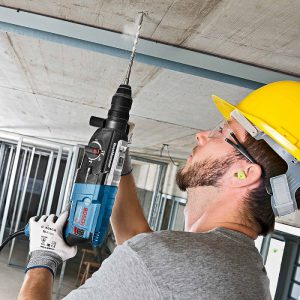
The general criteria for a successful purchase are very similar to the rules for purchasing equipment in general.When thinking about which perforator is better to choose for solving your problems, you should pay attention to the brand and the availability of a service center. For Chinese-made models, the choice of spare parts is relatively wide, but components for professional-level devices have practically no analogues. Even if the unit is designed for a long service life, a service center is still needed, because over time the carbon brushes wear out, and the gearbox needs to be lubricated periodically. It should also be borne in mind that not every tool can be serviced independently due to its complex design.
There is an opinion that professional-grade appliances are a priori better than household appliances, but this is a big mistake. Models for amateurs have a smaller resource, are inferior in terms of functionality and electronics, but are capable of performing all types of work. Professional rotary hammers are designed for long-term, intensive operation in various conditions, which can be expressed in increased protection against dust, the presence of control and monitoring electronics, and high technical performance. When it comes to small volumes of work, the difference between professional and amateur technology will not be noticeable.
An important criterion is the class of the instrument. The user must correctly assess the upcoming volume and type of work, this will help determine a number of suitable models. If your own experience is not enough, you can turn to the knowledge of the masters, they will tell you how to choose a good puncher and not spend extra money.
General classification of rock drills and their purpose
- Simple tools with mechanical shock will be useful for drilling wood and metal, for example, for drilling logs with twist drills. Concrete and brick work should be limited to infrequent use.
- Lightweight with "pneumatics" - models with a horizontal engine and a power of no more than 700 watts. Such perforators are suitable for apartment renovation and laying of utilities, because they easily drill concrete, brick, metal, wood.
- Average. This category includes the most powerful horizontal models with high impact force and all “vertical” rock drills with SDS-Plus chuck. A tool of this class is suitable for intensive use, including drilling and chiselling of load-bearing walls, where concrete is very strong.
- Heavy. In terms of its parameters, this type of hammer drill is superior to all other models. They differ in increased productivity and are used mainly for chiselling, for example, creating or expanding openings of doors or windows, they are used to demolish an old foundation. The technical feature of this class is high parameters of power and impact force, large mass, SDS-Max cartridge type.
If you are deciding which perforator to choose for concrete or brick, choose a model with a pneumatic impact. It is impossible to visually determine the type of mechanism, and not every seller will give full advice. It is easy to understand the issue: for models with a mechanical shock, vibration is felt at idle, and the pneumatics form a shock only under load, directly during drilling.
KRÜGER KBH-1400

An excellent ratio of price, functionality and quality is demonstrated by the German Kruger rotary hammer. It is a compact device that weighs only 3.1 kg, which greatly improves the ease of use.
Despite such parameters, the Kruger hammer drill is increased in power: this indicator in the device significantly exceeds the analogues of other manufacturers and is 1400 W. A rubberized handle is also provided for the convenience of users. It provides a secure grip and does not slip while working with the device.
Rotary hammer types straight and vertical
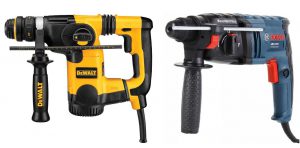
Structurally, all rotary hammers are divided into two large groups:
- Horizontal or straight.
- Vertical or L-shaped.
Models of the horizontal type are presented in a rich variety of modifications, the power of such tools does not exceed 1 kW.They have compact dimensions and low weight. If you want to find an inexpensive but good hammer drill, pay attention to models of this type, among them there are many successful versions at affordable prices.
Vertical engine models are more efficient. Due to the special design of such tools, the vibration level is reduced, a powerful electric motor is installed, respectively, and more weight. The power consumption for various models varies from 900 W to 1.5 kW, as a rule, hammer drills up to 1 kW are household. When choosing such a technique, you should follow the operating rules, especially for an amateur-class power tool. The lower part of the engine, where the vents are located, is not always equipped with a dust protection system, as a result of which there is a high probability of the ingress of abrasive particles.
Impact energy and frequency
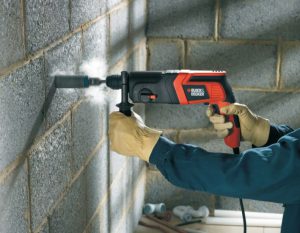
By the parameters of the perforator, one can judge its capabilities. Impact frequency and force are key factors in drilling performance and speed. Impact energy is measured in joules (J), for horizontal models the average value is 1.5-2.7 J, the limit value for tools of this class is 3.2 J. More powerful vertical rotary hammers with SDS-Plus chuck have an average impact force of 3 up to 7 J, and in productive and heavy SDS-Max, the parameter reaches 12.5 J.
The impact frequency of horizontal devices rarely exceeds 4000 bpm, but there are professional models where the rate reaches 4 300 bpm, like the Hitachi DH26PC. The limit value is 5 800 bpm - for the Bosch PBH 2000 RE household rotary hammer. For minor repairs in an apartment or in a country house, this indicator does not play a decisive role, but it is worth paying attention to it, the value should not be too low. Modifications with an L-shaped engine, designed to a greater extent for chiseling, the frequency of blows for such devices is slightly lower - about 3600 beats / min (Bosch GBH 4-32 DFR-S).
Summary: the impact force is especially important with intensive chiseling, the higher the indicator, the more efficiently the tool will cope with the tasks. The impact frequency determines the drilling speed.
How to choose the power of a punch
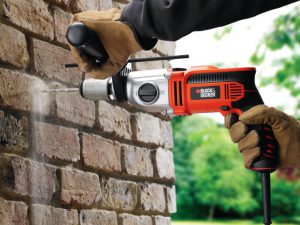
The rock drills are chosen among models of the same class for exceptional power. This indicator is not the main factor when buying, more important is the ratio of this value to such characteristics as the strength and frequency of impact. As the experience of the craftsmen shows, the difference in power of 650 - 750 W is not critical, if we are not talking about drilling load-bearing walls or foundations.
Among the recommendations on how to choose a hammer drill for home, experts do not single out a specific range. Modifications with power up to 700-720 W will cover all household needs. For construction, overhaul or redevelopment, choose between horizontal models (average 800 W) or heavy models for chiselling (1.1-1.2 kW or higher).
Shaft speed
The number of revolutions of the perforator has a certain value when performing specific work, but by and large this parameter does not play a significant role, especially when choosing an amateur-class tool.
Craftsmen who are professionally engaged in repair or construction, recommend choosing models with a high rotation speed for the production of small diameter holes or for working with thin walls, thin beams. If the task is to drill thick monolithic walls or logs, high speed will unnecessarily overheat the rig, which will somewhat accelerate its wear.
Drill mount type
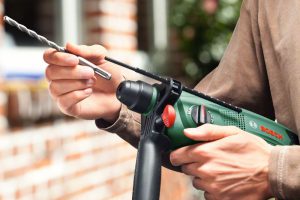
Another important division of rock drill models into groups - according to the type of equipment or the type of drill attachment. Today there are two main modifications: SDS-Plus and SDS-Max, similarly the equipment is grouped.
Cartridges SDS-Plus installed on all light and medium models, as well as on household and low-power devices with a vertical engine. Drills with a diameter of up to 32 mm, peaks, a bit with a similar fit are used as rigging.
Rotary hammers with mounting type SDS-Max Are always powerful models with a vertical engine and high impact force. Accessories for such tools start from 12-14 mm in diameter and reach 52 mm, the length of the drill varies from 310 mm to 1 m.The difference between consumables for this class of tools is a wide fit and 4 victorious solders at the drill's workplace, for SDS-Plus soldering usually 2.
Unlike a drill, the drill chuck is almost always built-in, like the Makita HR 2450, to use conventional drills with a cylindrical shank, a special adapter from SDS-Plus is installed on a conventional drill chuck. Among the offers from the best manufacturers of rotary hammers, there are modifications with a replaceable chuck - Makita HR 2450 FT, here the standard chuck for drills can be removed and a special chuck for drills can be installed. Naturally, this is more convenient than the combination of an adapter and a second chuck, but an additional accessory increases the final cost of the tool by a third.
Owners of models with SDS-Max mounting type can choose an adapter for installing SDS-Plus cartridges. Replacement chucks are not available for conventional drills with cylindrical shank.
Food type
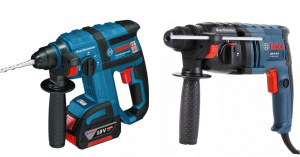
Choosing a good model for home or work, the user must decide on the type of power supply: mains or battery. With network punchers, everything is very clear, the unit is connected to an outlet or extension cord, respectively, if there is no electricity, the tool will not work.
When thinking about buying a cordless hammer drill, you should be aware of all the features of this technique:
- Battery life is limited by battery capacity.
- Choose the second option between the built-in and the removable battery. It is even better if the battery type is Li-Ion - they are much lighter than Ni-Cd.
- Wireless models are very convenient when working on the roof, in the country or in a garage without electricity, but in terms of power they are several times inferior to network punchers.
- The acquisition will be rational in a pair with a network tool. The mobile model helps out when connecting to the network is impossible or requires a lot of preparation, and the amount of work is small.
Number of operating modes
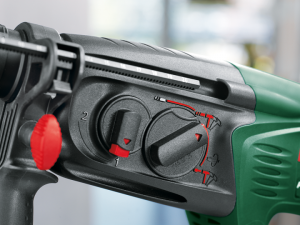
Depending on the modification, this power tool can have 2, 3 or 4 operating modes:
- drilling;
- hammer drilling;
- chiselling;
- tool rotation (used to set the blade to a comfortable position).
Dual Mode Rotary Hammers - these are tools for a narrow specialization, there are models where drilling / hammer drilling or hammer drilling / chiseling are combined. Such models are purchased for a certain range of tasks or in pair with another instrument.
Three-mode - universal models for a wide range of purposes. If you need a tool for various household chores - this is the best hammer drill among analogues. The fourth mode with the rotation of the scapula is convenient, but in practice this function is not critical; you can choose a convenient position in the drilling mode.
The mode setting method is always the same for horizontal engine models. - round regulator at the top or bottom of the body. The "vertical" switches are of two types: similar to the "horizontal" ones or in the form of two separate controls. In practice, there is no significant difference between them, the user can choose what is more convenient for him.
We also recommend reading our rating of the best rotary hammers for home use and work:https://intop.techinfus.com/en/reitingi/dly-remonta/rejting-luchshix-perforatorov.html
Functions that might be useful
When evaluating the functionality of a punch, you should know about the basic options. Sellers often talk about them as a unique feature, but in practice, this is just the minimum technical equipment. Such opportunities include reverse, its absence is rather an exception to the rule. Reversing will help remove the rig if it gets stuck in the material. Here it is worth paying attention to the type of switch, it is good if it is carried out with a separate key, and is not located at the start button, similar to an impact drill.
Locking the tool in the on position and a mechanical protection button are common basic options.
If the task is to choose a reliable hammer drill for the job, you should pay attention to the availability of additional functions:
- A safety clutch or KickBack Control technology is a useful safety option. When the rig is jammed, the electronics block the engine, protecting the operator from inertial shock.
- Automatic shutdown when carbon brushes are worn out - help protect the tool from breakage.
- The vibration damping system, like the GBH 2-24 Professional, is found mainly in professional rotary hammers. The option is very useful - it protects your hands during regular, continuous drilling.
- Smooth start when drilling reduces stress on internal mechanisms, this feature is most often found in powerful models.
In professional equipment of the higher price segment, there may be other options, for example, a dust removal system, like some Makita rotary hammers. These are no less useful technologies that significantly increase the final price of the unit. How rational the overpayment will be depends on the type and conditions of work.
Recommendations for care and use
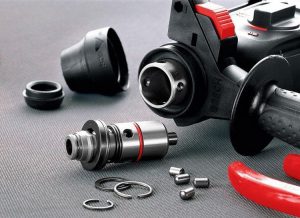
Compliance with the operating rules is a guarantee of long years of service of the tool and this applies to all models. First of all, it is necessary to study the user manual, where there is always a general list of requirements.
It is important to know that the time of continuous work is never indicated, for a household-class tool the limit is 4-6 hours a day with regular breaks. Professional models can work for 8-12 hours with rare stops and are superior in reliability to amateur rock drills.
The most common cause of breakdowns is the ingress of concrete or brick dust, abrasive particles into the housing. This happens in three cases: if you do not clean the tool after work, if you work in a very dusty room with a household tool, or put the hammer drill on a dusty floor until the engine stops completely (frequent breakdown in models with a vertical engine).
The result is a non-warranty repair and replacement of the main parts; regular cleaning of the tool will help to avoid such breakdowns. It is useful to carry out routine maintenance of the tool in an authorized service, where the master will open the hammer drill, lubricate the gearbox, check the condition of the carbon brushes, and remove dust.
Finally, experienced experts recommend keeping an eye on the tool while working. Severe overheating of the gearbox can cause serious damage. In rare cases, such an operating mode is standard, but this is rather an exception to the rule.
Which company to choose a hammer drill?
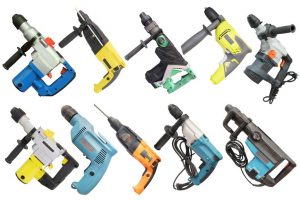
The number of manufacturers of such a popular tool as a hammer drill is estimated in hundreds of brands. It is best to give preference to one of the leaders in your industry, because the concept of “brand” means not only increased cost, but also our own developments and technologies, verified designs, and rich experience of engineers. Among the popular manufacturers of high-quality rotary hammers in the price-quality ratio, the following stand out:
- Bosch
- Makita
- DeWalt
- Interskol
- Metabo
Outcome
In order for the purchase to be successful, one should clearly understand why a new tool is needed, what tasks may arise during the repair or construction process. Much has been said about how to choose a perforator on your own and which model is better for home or work, but in conclusion, you can add one more useful advice from professionals - to purchase only the model that fits comfortably in your hands. The right combination of technical features and decent ergonomics will be the key to productive work and long tool life.



